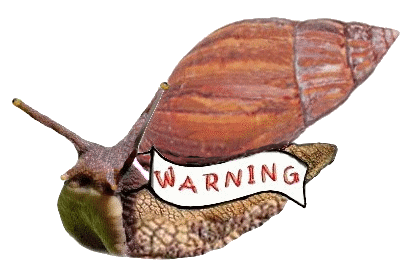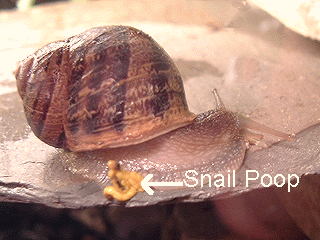#1: Odessa talks to Oreo about Giant African Land Snails:

Hello Oreo,
Today, I need to tell you what I have learned about a huge snail called the Giant African Land Snail.
|
It
is the biggest land snail (science people call it a terrestrial snail
which is just another way of say that it lives on land) on our planet.
You're not going to believe this but its true.The Giant African Snail's
shell can grow up to is 8.07 inch.(20.5 cm) and, when its body is fully
extended, the length of it's soft body can be up to about 12.25 inches
(31.1cm ). It can grow to a weight of 1 pound 5 ounces to 1 pound 8 ounces |
Damien ( Helix aspersa ), on the tape measure has been super imposed just for a comparison |
Just think of how much bigger it is then us or any other snail! It reproduces by laying eggs and one of it's eggs and, just one of those egg can be the size of you or me!
GALS (acronym for Giant African Land Snails) are known to eat at least 500 different plants. It can and will climb tree while eating that trees bark. It will even climb houses and buildings where it eats the paint right off of the house or building!
No wonder its known as the largest terrestrial Gastropod in the whole world. (Note: Gastropods are molluscs - or more commonly known snails, and they are one-pieced shelled molluscs as compared to Bivalves which have a hinged two-part shell)
These snails are native to Africa. Now they are here in the United States and many other places. See NOTE.
Mom told me the true story about a Miami boy who smuggled three giant African land snails into the Florida United States in the 1960s. His Grandmother released them into her garden. (Can you imagine what those three did to that garden?) In seven years those three snails laid eggs and multiplied to 18,000! Wow!
You see here in the USA we do not have have any native snail predators to keep immigrant snails in such numbers in check. It has cost the state of Florida in the millions of dollars to get rid of them or at least get them under control. Even if they people of Florida thought they found all the snails, which would be highly unlikely; they wouldn't be able to find all the the eggs laid by all the snails.
(My Mom told me that a friend of hers saw one in the wild, not to long ago. This friend was was on camping vacation in Florida. So, that tells us that Florida still has at least some of these problematic snails crawling around loose! )
Here is the part that is so very important - The Giant African Land Snail can, and often do, carry a few different diseases that can infect humans. It can even carry a parasite which can cause meningitis in humans. This is a very, very serious disease in humans and it can even be fatal. You can get this by just handling an infected snail. (NOTE:There have been no noted cases in the USA that I know of to date - lets not have a first case)
Mom told me that GALS because of their size are a favorite pet snail to keep. They are easy to handle because of their large size, they are relatively easy to keep and they are fun. Many schools world-wide have even kept them as classroom pets. Why, not long ago, some of these snails were discovered here in a USA schoolroom not too long ago ! The children were studying them and they were pets. The teacher had brought them to school. The teacher, didn't know (or at least I hope he or she didn't know) they were illegal and on the Most Wanted List.
Oreo, wouldn't it make us sad if even one child got sick because the had Giant African Land Snails as a pets at home or in school.
You must remember before deciding to keep a GALS as a pet that they are destructive, invasive, dangerous and illegal here in the USA and in many other countries around the world. If released into nonnative environments, they have enormous destructive potential and are serious agricultural pests.
NOTE: In some
countries GALS are legal to keep as pets. But, in that same country it may be
illegal to release them or their eggs into the wild.
Mom asked me to pass on this message to everyone reading this article:
"If you have a land snail and you are unsure of what kind (species) it is and you are now worried that it might be a G.A.L.S. there are ways of telling. The size of your snail is the most identifying factor. If the snail's shell is more than two inches long, the snail is more than likely a Giant African land snail.
There are also people around the world that are willing to help you identify the correct species that your pet snail is. Some of these are:
If you find out that you do indeed have a GALS, you must become a very responsible pet owner.
Third: if they are illegal in the country where you reside, you must never, ever, release these snails into the wilds. They and their eggs must be properly disposed of. If you are unsure of how to do this, the Department of Agriculture in your country will be able to help you out.
Fourth: If they are legal to keep as pets in your country, be responsible and do not turn your pets or their eggs out into nature. It is hard to think that a pet may have to be put down but it is for the good of man kind. Keep your pets in secure pens or terrariums so that none can escape. Use good cleaning practices to keep both you and your pet healthy.
Oreo, when this snail gets loose, the damage it could cause could be a real nightmare. They might eat up so much of the local food that they could starve out other native snails and animals. Farmers could lose entire crops and all the people in that sate or country would suffer. Whole habitats could be destroyed and many animals and plants could be completely wiped out or even become extinct.
|
Another thing to consider before keeping any pet snail is they poop a lot. Remember, I told you that GALS eat a lot, well, I do not have a picture of GALS poop, (feces) but I do have a picture of my brother Demeter ( Helix aspersa ) to show you.
He is no where as BIG as a GALS (see comaparison photo above), but just look at the poop he can produce. YUCK! Just think of how much just one GALS would produce! |
 |
Isn't that disgusting!!!! Boy oh Boy; Would my Mom and Dad be upset and down
right freaked-out if something pooped all over our yard and house. I would be
too!
Oreo, many, many people world wide are keeping these snails as pets and we must carry on our crusade and beg people to -- Please oh please, DO NOT RELEASE YOUR SNAIL INTO THE ENVIRONMENT,SELL IT, OR GIVE IT AWAY. Instead contact your local Department of Animal and Plant Health inspection Service office located in your area. In the USA the USDA will tell people what to do. (See NOTE)
Oreo, I
know you and I are working hard, to get the word out. The good feeling we have
sure outweighs the work, we both agree on this. Its wonderful when friends work
together to do good. I would love to see a few more friends get together and
do what we are doing. They would have that good all over feeling too. Its also
nice that our Mom's are even helping a little bit, don't you agree?
|
Well, I'm hungry right now so I think I will stroll over to old fed trough and see what Mom has put out for dinner. So bye for now, Love,
|
 Dinner time at Odessa's home |
See: The
"Most Wanted Poster"
for the African Land Snail:
by Oreo and Odessa
edited for content by Avril Bourquin
![]() NOTE:
The U. S. Department of Agriculture's Animal and Plant Health Inspection
Service (APHIS) is interested in finding
these snails, and encourages those using these snails in classrooms, nature
facilities, or keeping them as pets to turn them in voluntarily without fear
of penalty.
NOTE:
The U. S. Department of Agriculture's Animal and Plant Health Inspection
Service (APHIS) is interested in finding
these snails, and encourages those using these snails in classrooms, nature
facilities, or keeping them as pets to turn them in voluntarily without fear
of penalty.
If you have a giant African
land snail PLEASE DO NOT RELEASE IT INTO THE ENVIRONMENT OR GIVE IT AWAY; OR,
or if you find giant african land snail, PLEASE report it to your State Department
of Agriculture (you will find this office listed under State government in your
phone book, or on the web at: http://www.aphis.usda.gov/npb/npbmemb.html#Members),
or to the US Department of Agriculture Animal and Plant Health Inspection Service
office in your state (you will find this office in your state listed under Federal
or U.S. government in your phone book, or on the web at: http://www.ceris.purdue.edu/napis/names/sphdXstate.html).
At the present time snails found in the United States have not been shown to
be disease carriers. For more information, see the following web site: http://www.cdc.gov/ncidod/dpd/parasites/angiostrongylus/factsht_angiostrongylus.htm.
NOTE: This snail (a native to Africa) has been widely introduced to the USA (mainland & Hawaii), to Asia, to the Pacific and Indian Oceans Islands, to Brazil, and to the West Indies. It can be found roaming freely in such habitats as agricultural areas, coastlands, disturbed areas, natural forests, planted forests, river and stream banks and, scrub/shrublands, urban areas, wetlands ...in other words, almost everywhere they are established and wish to reside.
|
Retrun
to the Odessa-Oreo
Article Index |
Return
to Man and Mollusc
Home Page |
